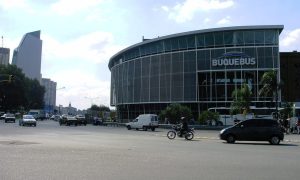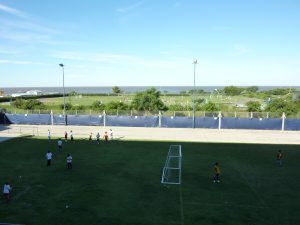
Monday morning we woke up to blue skies and just a little humidity. The first order of business was to figure out how to acquire our rental car. Luckily, I had Mercedes to help. She made a few calls and eventually found someone that knew what the heck was going on. She gave me an address and called a remise from the same service that had picked us up at the airport. I thought remise was a Spanish word, but later learned it was common in old English and means “an expensive or high-class hackney”. In other words, a private ride instead of a regular cab.
20 min and AR$100 later, we arrived at the Buquebus ferry terminal near downtown. There are many more details on the agony of renting a car on this post over at OpenKimono, but I will say it’s a far cry from the processes in place in the US. It’s almost as though the rental car companies don’t actually want to rent a car to you. Very weird.
After finally securing the car, it was time to venture onto BA’s wide avenues and see the sites. Before we departed from Colorado, Julie had done a bit of research and determined the best way to see the city’s sites in a rapid fashion was via the Buenos Aires Bus, a double deck tour bus that loops around the CBD and stops in various locations where you can hop off / hop on. We decided to go find the spot where the tours began. I plugged the cross streets into TomTom and off we went into the utter chaos that is midday traffic in BA. I’ve driven in Manhattan and San Francisco at rush hour and both are pretty much a joke compared to BA’s Central Business District (CBD). The problem is that while lanes are marked, they are meaningless. You don’t see many big cars there, so the typical vehicle is about 2/3 of the lane. For Porteños, this means there’s room for 3 cars across 2 lanes. Duh. Why not? Mix in the occasional full-size BMW or Mercedes-Benz, tack on some big old Scania semi-trucks, a swarm of scooters and a liberal application of bicyclists and you have what amounts to complete anarchy for your typical North American driver. Luckily, I revel in driving challenges and it didn’t take long to learn both the written and unwritten rules of the road. Doug Parker had also given me a few tips during our wanderings the day before.

What I didn’t expect was for TomTom to be nearly useless. While he technically knew how to get someplace, he lacked a practical understanding of BA’s thoroughfares and side streets. More than once he suggested a left turn at an intersection that was clogged with traffic and often took me down narrow, one way corridors with cars, motor bikes and trucks parked haphazardly along the side of the street. BA drivers also use their horns liberally, so getting anywhere in the CBD quickly becomes a cacophony of horns, revved engines and yelling. Relaxing, really.
We eventually found the kiosk for the tour bus, but it was evident parking would be a challenge. The buildings were side by side with nary a parking lot in sight. It seems all the parking is underground and you just need to know where look, which we didn’t as it wasn’t until later that we learned all the big “E” signs meant “Estacionamiento” and not “Emergencia”. I guess I should have questioned how there could be emergency related something or other (doctor’s office, free phone, etc.) on every other block. Amateur move on my part.
So, we decided to punt and told TomTom to take us back to San Isidro, saving the bus tour for the next day when we could plan a little better. In a few minutes we were cruising northwest on Avenida del Libertador, viewing the parques and plazas that line either side of the road for several kilometers running north out of the CBD. We eventually found ourselves back in the small San Isidro town center, which was very quiet in the middle of the day. We ventured into a little restaurant called Ummus and were able to navigate the menu to order some pizzas for the girls, pasta for Julie and a sandwich for me. Lunch for four ran about AR$115 plus a 10% tip in cash (tipping on credit cards is not favored). Plus another AR$1 for the dude watching all the cars parked on the streets near the shops. Tipping of informal security guards is something I found to be common in South Africa and Argentina is no different. Just a little cash back into the underground economy.
Much like New York, there was a wave of Italian immigration to BA in the early 20th century and their cultural sway has lasted up to the present with an influence on both language and food. Linguistically, the local Spanish dialect is called Rioplatense and it possesses a prosody that language experts say is similar to Neapolitan. In other words, spoken Spanish here sounds a lot like Italian. And there are Italian cafés, gelato joints and pizzerias all over the place. Like New York, BA is also known for its pizza. Before our trip, we tried BA-style pizza at a Denver restaurant aptly named Buenos Aires Pizzeria and we determined the real deal in BA is very similar. The crust is a thick, soft, a bit doughy and oven baked. I’m a pizza aficionado and while I prefer thinner crust, wood fired type pizza (Col’Cacchio Pizzeria in Fairlands, Jo’Burg, RSA is a favorite), the BA-style is certainly edible and the kids loved the over abundance of cheese.
After lunch, we headed back to hacienda Parker to check in and figure out our next steps. Before long, we found ourselves back in the car heading off with Kelly to Unicenter, the local shopping mall. Unicenter is a 3 story mall like that you see in any major American city with a few sit-down restaurants, clothing stores and a multi-screen cinema. It’s anchored at one end by a Falabella department store and a Jumbo hipermercado at the other end. And it has a Starbucks. I don’t recall seeing another one anywhere else in the city, but there’s one at the Unicenter.

We cruised the mall for a while, then headed back out to pick up the Parker girls at their school, Asociación Escuelas Lincoln. Lincoln is one of the international schools and most classes are taught in English (strangely, Spanish class is taught in Spanish :-P). Most of the students are the children of ex-pats or wealthy local families. Getting on the school grounds wouldn’t have been possible if Kelly wasn’t with us as there’s a fair amount of security around the school including a tall fence and a number of guards at the gate. We toured the school, then wandered to the east side of the building where we found ourselves on a concrete terrace overlooking several acres of soccer pitches laid out between the school and the edge of the grounds on the banks of the River Plate. A very nice view and pretty impressive. Below us, we watched Lauryn practice. There looked to be 4 girls and about 20 boys. Apparently, girls in Argentina play field hockey, not futbol. Lauryn’s coach only spoke Spanish and I was amazed she was picking up anything having only been in Argentina for about 8 wks to that point.
After practice, we piled again into the car and headed for home via Juan Diaz de Solis, a street that parallels the River Plate for several kilometers. Along the river side of the street we noticed a scattering of grassy fields next to bars and restaurants like you’d see in a California beach town. Apparently, these places are pretty lively on the weekends with city folks looking for a river breeze, a bit of green and a cerveza. When we arrived home, I found there was still time for a run before dinner, so off I went on the sidewalks and paved trails that parallel the tracks of the Tren de la Costa (more on this train later). ~3 miles and 25 min 30 sec later I decided that despite the low elevation, I was still slow. Much more sweaty than usual, but slow. Returning from my run, I found Doug had arrived home after dropping off his car for a pair of new tires. He explained simple things are often hard and slow in Argentina. How long will it take for the new tires? 2 days.
We enjoyed another great meal at home, this time prepared by Margarita, an Argentine woman the Parkers hired to help with some domestic tasks. Having help is also pretty common in Buenos Aires as, despite a relatively high cost of living, labor is relatively inexpensive. While domestic help is pretty easy to come by, just like in America, good help is hard to find and the Parkers did well with Margarita as she’s not only a very nice woman, she’s a great cook. After getting the kids off to bed, Julie and I enjoyed a bottle of wine with Doug and Kelly (¡Malbec! ¡Malbec!) while we schemed up plans for the next day.